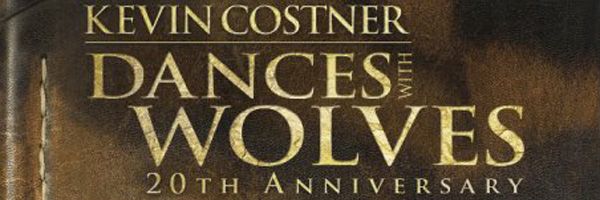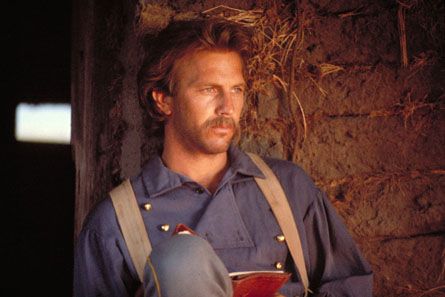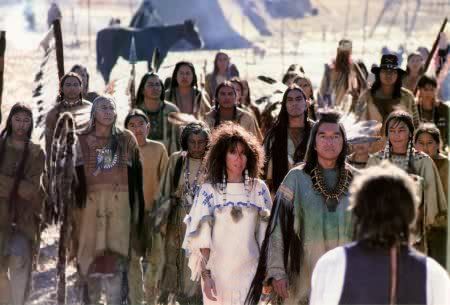Kevin Costner’s moment at the top of his arc was undoubtedly Dances with Wolves – everything since has been part of his decline. He had box office hits/classics with such films as The Untouchables, Field of Dreams, No Way Out, and Bull Durham. He was a sex symbol, a guy’s guy, the next Gary Cooper – down to Earth, and sexy in a way that suggested distinct heterosexuality. Then came Dances with Wolves, and it was there the stage for Costner-backlash was set: Wolves trumped Goodfellas and Martin Scorsese for best picture and director. The film had been loved, but there were dissenters (including Pauline Kael), and by the time Costner got around to directing again (1997’s The Postman), he had already made Waterworld and a number of films that won him no fans. Twenty years on it’s interesting to revisit his Dances with Wolves, as the film has both been overrated and over-hated over the course of two decades, and my review of the film on Blu-ray in an extended director’s cut follows after the jump.
Costner directs and stars as Lt. John Dunbar, who begins the film on a suicide run after he’s told his foot might be amputated. His stunt starts a fight his side wins, and leads him to a promotion. He chooses a post in the Wild West as he wants to explore the country. He has a sidekick (Robert Pastorelli), who leaves the film shortly after taking him to his station. There he makes friends with a nearby wolf, and notes that the Indians are nearby, but is cautious about approaching them. Eventually an opportunity presents itself, when he rescues Stands with a Fist (Mary McDonnell). With that he gets to know the tribe and ingratiates himself in with them - including the person he most sees as a leader Kicking Bird (Graham Greene). He comes with them as they hunt buffalo, fight off warring tribes, and romances Miss Fist, but he must comes to face with the culture he left behind once more.
For modern audiences, Dances with Wolves may come across as a live action version of Avatar. And what was once the great sticking point with the film is still the most interesting thing about it: The racial politics. It’s hard to argue that the film doesn’t follow the now classic “why can’t I be a part of a minority” narrative that seems inherent to liberal white guilt, and has been seen in such films as The Last Samurai and Avatar among others. But the idea of the pure Indians and evil whites is at least toyed with by Costner and his writer Kevin Blake, and if the film benefits from anything in the Director’s cut (which – frankly – is too long and not the best cut of the movie), it’s that the racial polarization seems less apparent. But even in the theatrical cut, there were good white people and bad Indians. There are some gradations, but the movie ends with white people taking shots at the wolf that Dunbar defends. It’s so over the top that instead of having an emotional impact, it feels like overkill. The film is not all that bright or insightful, but if it works – and I think it does for the most part – it’s because it works as a travelogue.
Watching it theatrically in 1990, I was 14, and hadn’t seen that many westerns (my father let me grow up on action films of the era). Over the last twenty years, I have seen almost all of the canonical westerns of note, and so my appreciation for the film has changed. You could argue that maybe there’s a little John Ford in there, but Costner isn’t really after imitation, he’s more interested in the landscapes. I would argue that Robert Flaherty had something of a bigger impact, though Costner’s majesty is more of a point and shoot variety.
But if this film works (and it does more than it doesn’t - though it’s altogether too long), it’s because of the soundtrack by the recently deceased John Barry and the cinematography by Dean Semler. The film is stunning to look at, and the sweeping vistas are well represented by the Blu-ray presentation. There’s a shot that’s Costner at magic hour that’s so great the film cuts back to it moments later, knowing that it’s a money shot. While John Barry’s score sounds very Barry (you might get a twinge of Bond in there), he was the only person who could give the sort of old school Hollywood sweep. Barry won an Oscar for his work here, and few times has the Academy been so right. With the charging buffalo, and nature photography, Dances with Wolves is at least not boring, but it falls into that category of Oscar winners of the time: Safe, not as terrible as reputation might suggest, but decidedly not a masterpiece.
Fox presents the Orion film in widescreen (2.35:1) and in DTS-HD 5.1 surround. Included here is the director’s cut (which runs 234 minutes) and not the theatrical cut (181 minutes). With Blu-ray such as it is, I really wish the theatrical cut was included, if only so this could be closer to definitive. The presentation of the film is flawless though. Shot by Dean Semler, the film glows, and the great score by the late John Barry is that much more fun to listen to in 5.1 DTS-HD. Extras on the first disc include a commentary by Kevin Costner and producer Jim Wilson, and a second track with Dean Semler and Editor Neal Travis. I was drawn more to the tech track, but Costner is fun to listen to, very honest, while the Semler/Travis track has more gaps. The first disc has a trivia track that lists characters ranks and positions called “Military Rank and Social Hierarchy Guide” and then there’s a trivia game that asks 30 questions throughout the movie.
Disc two has the rest of the featurettes, and they are presented on a Blu-ray disc (sometimes they’ll included a SD disc instead), though all the supplements are from previous releases it seems. It starts with “A Day in the Life on the Western Frontier” (14 min.), which offers comments from historians and the writer Kevin Blake on what it would be like to live in that time, and is followed by the original making of (21 min.), with comments from Kevin Costner, producer Jim Wilson, writer Kevin Blake, Mary McDonnell, Graham Greene, and others from the cast and crew. Then there’s “The Creation of an Epic” (75 min.) on the film and its legacy with comments from Wilson, Blake, Costner, Dean Semler, McDonnell, composer John Barry, editor Neal Travis, and many more. If the first making of is fluffy, the second one at least digs a little deeper into the film’s production history and release, and has some interesting comments from McDonnell. Then comes the section “Vignettes” which starts with a music video that modernizes John Barry’s score to behind the scenes footage, it’s followed by “Second Wind” (5 min.), and “Confederate March and Music” (2 min.) which highlight the music in the film, and the extras. “Getting the Point” (4 min.), “Burying the Hatchet” (1 min.) and “Animatronic Buffalo” (2 min.) look at some of the special effects of the film. There’s also a trailer, two TV spots, a poster gallery and a photo montage with introduction by set photographer Ben Glass (9 min.).



